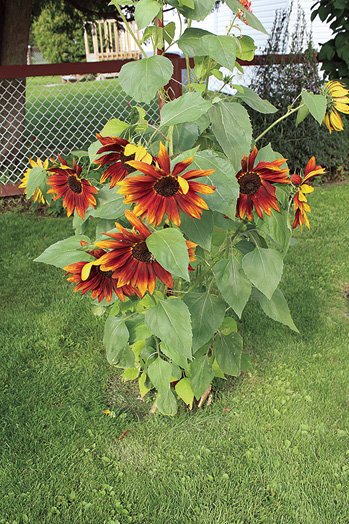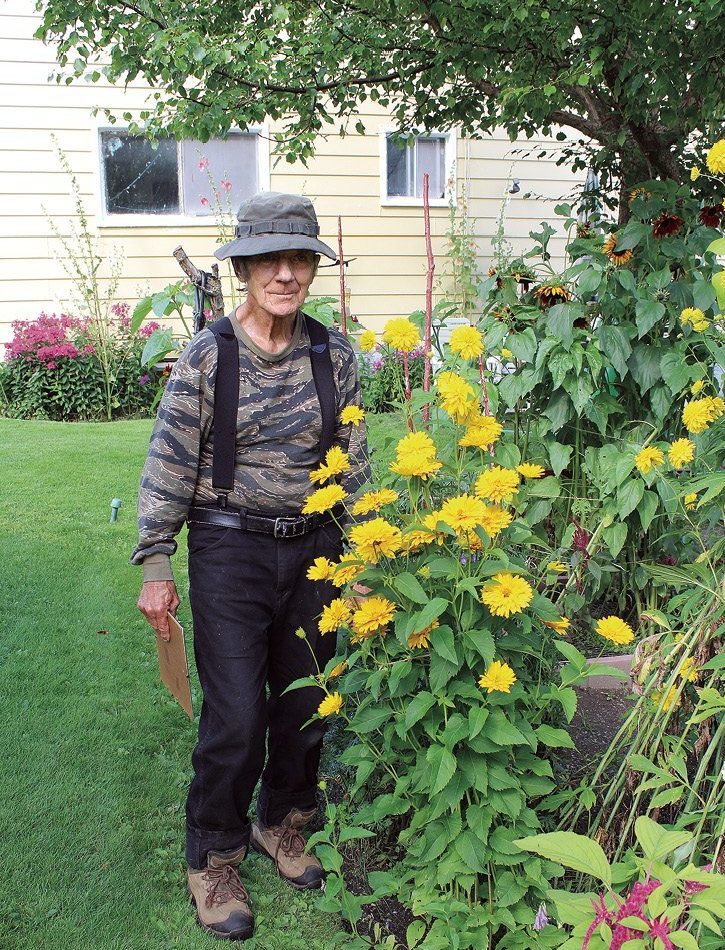It is often said that the best way to know a person is not by their words, but rather by their deeds. When it comes to Reynard Abrahamson and the gardens he has carefully cultivated over the years in the heart of Nipigon, there can be no doubt that he is a nurturing and patient man.
The 83-year-old shared that when he first moved to his house on the corner of Bell and Railway Street, the double lot did not have any formal garden. “Just a rudimentary place to grow potatoes.” He started out growing a mixture of vegetables and flowers. But now his gardens primarily consist of special landscape plants.
Some of the most striking plants in his gardens are the pacific giant delphiniums. They grow so high that they can “reach the sky,” Abrahamson enthusiastically confided. One summer, a tourist from the United States was driving by and was so impressed with the dazzling spikes of clustered blue flowers, that she took several pictures. They were featured in the world-famous magazine Birds and Blooms.
The dahlia is also an eyecatcher. It grows about 5 feet tall and produces flowers that are about 8-10 inches in width. They come in different colors, but Abrahamson prefers the red ones. He stated that they are a sensitive plant and cannot be shipped in cool weather. Nor can they get too hot. They arrive as roots which he keeps in the house until he is sure no frost can harm them, then he plants the dahlias along the fence. Another plant that cannot tolerate the cold is the gladiolus or glads. It has to be staked and comes in a variety of colors.
Lower growing plants also grace the gardens. They include the multicolored tulips that bloom in early spring, the bulbous daffodils with their yellow stately blossoms, and Abrahamson’s favorite; the mallow with its rose-colored flowers.

Another plant that stands out for its splendor is the rudbeckia laciniata hortensia. It is also known as the golden glow because of the large yellow blossoms it produces. There was a time when people thought they were nothing more than weeds and were often used by farmers to divide their crops. Abrahamson is fond of them because they can grow over 6 feet tall and “wave at the cars as they go by.” Also, because they offer a great contrast to the sunflowers he plants each year.
Abrahamson is partial to the ruby passion flower because of its crimson accented petals, and the Russian giants which have brilliant yellow heads filled with edible seeds.
Late in the summer, the flowers on the blazing star or liatris appear in full bloom. Abrahamson refers to them as cat tails because their long spires are filled with white and purple flowers that have a fuzzy furlike quality to them.
The only vegetables he plants are corn in the main garden and tomatoes. Abrahamson explained that he starts the tomatoes in the house. When there is no risk of frost, which is usually after the first week of June, he carefully transplants them outside.
When it comes to giving advice to others, Abrahamson said, “You can amend the soil, but you can’t change the climate.”
When he first started gardening, he made his own compost. He later switched to peat moss, because it was less time consuming. He has found that the plants that do the best in his area are identified on the United States National Arboretum map as belonging to Zone Two. Abrahamson always makes sure the containers he uses to hold the plants have holes in the bottom for adequate drainage. When it comes to watering the gardens, he waits until the soil is dry but not “bone dry.” If there is a risk of frost, he uses plastic and stressed that this protective covering should never touch the plants.
A few years ago, the township of Nipigon hosted a dinner for Abrahamson at the Legion. He was given a plaque that acknowledged his undisputed ability to grow magnificent plants.
“I don’t know if I’m a good gardener, but I’m persistent,” said Abrahamson.
Abrahamson went on to explain that gardening gives him a feeling of accomplishment and time to think. And there can be no doubt that his thoughts are grounded in a beauty that transforms his yard into a botanical paradise year-after-year.




